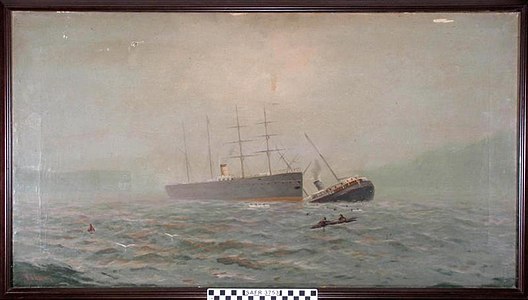SS City of Chester
 | |
| History | |
|---|---|
| Name | SS City of Chester |
| Owner | Oregon Railroad Co. |
| Operator | Pacific Coast Steamship Company |
| Builder | John Roach, New York[1] |
| Completed | 1875 |
| Fate | Sunk in collision 22 August 1888 |
| General characteristics | |
| Tonnage | 1106 |
| Length | |
| Beam | 33 ft |
The SS City of Chester was a steamship built in 1875[4] that sank after a collision with RMS Oceanic at the Golden Gate in San Francisco Bay on August 22, 1888.
City of Chester was 202 feet (62 m) long.[3] She was owned by the Oregon Railroad Co. and leased by the Pacific Coast Steamship Company.[2][5]
Sinking
Headed to Eureka, California, with 90 passengers on the foggy morning of August 22, 1888, at about 10 am she collided with RMS Oceanic, a liner inbound from Hong Kong.[6] The two ships saw each other, but as was later determined by a British Naval Court, City of Chester was caught by tidal current and carried into the path of the larger ship.[3][7] An eyewitness aboard Oceanic said: "Into her we crashed with irrisistible force, cutting her just as though she was a cheese."[8] She sank in six minutes, and despite rescue efforts by those aboard Oceanic, sixteen passengers, including two children, and three crew members died.[3] In terms of loss of life, this is the second most deadly wreck in the history of San Francisco Bay, after the sinking of the SS City of Rio de Janeiro in 1901.[9]
Oceanic had Chinese crew and her steerage passengers were Chinese immigrants; anti-Chinese xenophobia was high in the US at the time and initially the Chinese were accused of letting City of Chester's passengers drown. When news of their efforts to save them came out, it helped to reduce the prejudice against the Chinese.[3][6]
Discovery of wreck
The wreck is located in 216 feet (66 m) of water just inside the Golden Gate Bridge at 37°48′50″N 122°28′00″W / 37.81389°N 122.46667°W[2][9] and was found in May 2013 by NOAA Office of Coast Survey Navigational Response Team 6 using multi-beam sonar.[3][6] It is only 400 feet (120 m) from where it was located by a precursor of NOAA, the U.S. Coast and Geodetic Survey, in September 1888 in a geodetic survey using a wire dragged from the tug Raymond.[3][6][10]
An exhibit on City of Chester is to be created at the Gulf of the Farallones National Marine Sanctuary office at Crissy Field. The office occupies the building erected as a lifesaving station in response to the disaster.[6]
Gallery
-
Oil painting by Robert Gilbert of the collision of Oceanic and City of Chester near Fort Point in 1888
-
Illustration of the collision from the San Francisco Chronicle
References
- ^ "Steamship 'City of Chester'". Daily Alta California. April 18, 1877. p. 1.
- ^ a b c "Shipwreck Database". California State Lands Commission. Retrieved April 24, 2014.
- ^ a b c d e f g Fimrite, Peter (April 23, 2014). "Sunken ship discovery in SF Bay revives memories of xenophobia". San Francisco Chronicle.
- ^ Berman, Mark (April 23, 2014). "A 19th-century shipwreck near the Golden Gate Bridge was just discovered (again)". The Washington Post.
- ^ "Miscellaneous". Daily Alta California. February 14, 1891. p. 6.
- ^ a b c d e "NOAA Coast Survey ship finds 19th century shipwreck off Golden Gate Bridge — again". NOAA. April 23, 2013.
- ^ "The Tide Did It: Verdict of the British Naval Court on the Bay Disaster". Daily Alta California. August 30, 1888. p. 1.
- ^ "Sickening Sights: A Passenger's Vivid Description of the Catastrophe". Sacramento Daily Union. August 24, 1888. p. 4.
- ^ a b Dearen, Jason (April 24, 2014). "Images released of shipwreck in San Francisco Bay". Yahoo! news. AP.
- ^ Occidental & Oriental Steamship Company v. Henry F. Smith, et al., 209–218 (9th Cir. 1894), Text.
Further reading
- "Sunk in the Bay: The City of Chester Run Down By the Oceanic". Daily Alta California. August 23, 1888. p. 1.
- "The Bay Tragedy: Officers of the Oceanic Praise their Chinese Sailors". Daily Alta California. August 24, 1888. p. 1.
- "On Board the Oceanic: A Talk With Chief Officer Tilston—How His Men Acted". Daily Alta California. August 24, 1888. p. 1.


